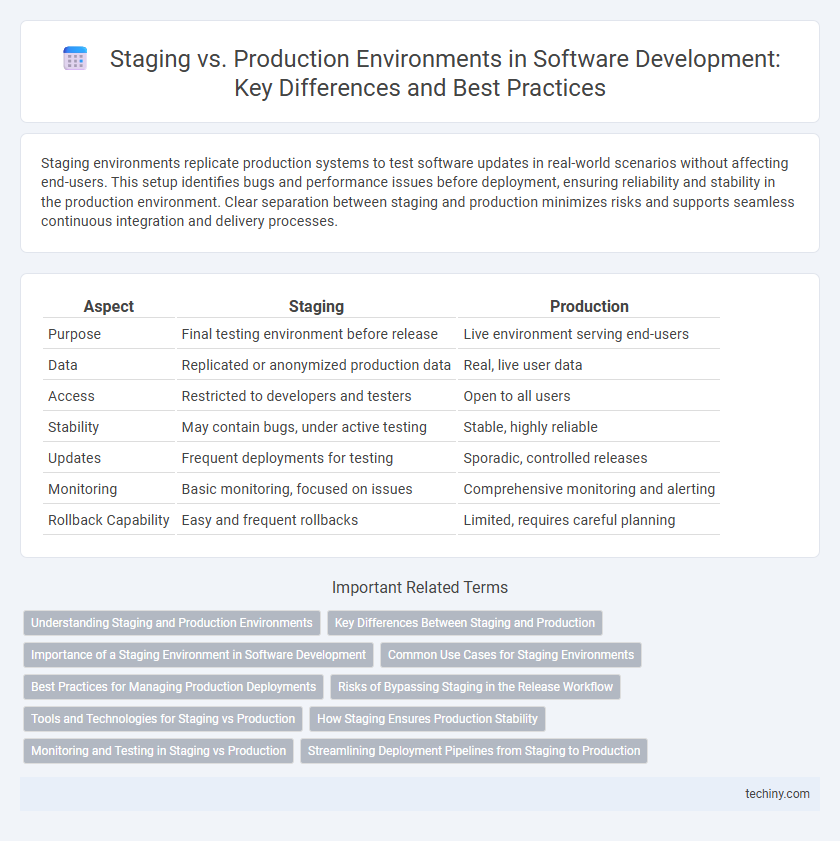Staging environments replicate production systems to test software updates in real-world scenarios without affecting end-users. This setup identifies bugs and performance issues before deployment, ensuring reliability and stability in the production environment. Clear separation between staging and production minimizes risks and supports seamless continuous integration and delivery processes.
Table of Comparison
| Aspect | Staging | Production |
|---|---|---|
| Purpose | Final testing environment before release | Live environment serving end-users |
| Data | Replicated or anonymized production data | Real, live user data |
| Access | Restricted to developers and testers | Open to all users |
| Stability | May contain bugs, under active testing | Stable, highly reliable |
| Updates | Frequent deployments for testing | Sporadic, controlled releases |
| Monitoring | Basic monitoring, focused on issues | Comprehensive monitoring and alerting |
| Rollback Capability | Easy and frequent rollbacks | Limited, requires careful planning |
Understanding Staging and Production Environments
Staging environments serve as a critical testing ground that closely mirrors production, allowing developers to identify bugs and performance issues before deployment. Production environments host the live application where real users interact, demanding stability, security, and optimal performance. Understanding the distinctions between these environments ensures a smooth transition from development to release, minimizing downtime and user disruption.
Key Differences Between Staging and Production
Staging environments mirror the production setup to test new features and fixes under realistic conditions before release, minimizing risks of bugs affecting end users. Production environments host the live application where real users interact with the software, demanding high availability, security, and performance. Key differences include access control, data integrity, and deployment frequency, as staging allows iterative testing while production ensures stability and reliability.
Importance of a Staging Environment in Software Development
A staging environment is critical in software development as it serves as a replica of the production environment, enabling thorough testing and validation before deployment. It helps identify and fix bugs, performance issues, and integration problems without impacting end users or live systems. Effective use of staging ensures higher software quality, smoother releases, and reduced risk of downtime or failures in production.
Common Use Cases for Staging Environments
Staging environments replicate production systems to allow thorough testing of new features, bug fixes, and configuration changes without impacting live users. Common use cases include performance testing, user acceptance testing (UAT), and final quality assurance (QA) to ensure seamless deployment. These environments help identify integration issues and validate scalability before production release.
Best Practices for Managing Production Deployments
Effective production deployments require thorough staging environment testing that mirrors the production setup to detect issues before release. Implementing automated deployment pipelines with rollback capabilities minimizes downtime and reduces risks associated with new releases. Consistent monitoring and real-time logging during production ensure rapid identification of anomalies, enabling swift incident resolution and maintaining application stability.
Risks of Bypassing Staging in the Release Workflow
Bypassing the staging environment in software development exposes production to untested code, increasing the risk of critical bugs and system failures. Without thorough validation, new features and updates may introduce security vulnerabilities, degrade user experience, and cause service downtime. Ensuring changes pass through staging mitigates these risks by enabling comprehensive testing and quality assurance before production deployment.
Tools and Technologies for Staging vs Production
Staging environments utilize tools like Docker Compose and Kubernetes namespaces to replicate production settings for thorough testing and validation. Production environments rely on robust orchestration technologies such as Kubernetes clusters, Terraform for infrastructure as code, and continuous deployment pipelines with Jenkins or GitLab CI/CD to ensure stability and scalability. Monitoring tools like Prometheus and ELK stack are essential in both environments but are configured more extensively in production for real-time performance tracking and incident management.
How Staging Ensures Production Stability
Staging environments simulate production settings to identify bugs and performance issues before deployment, reducing the risk of failures in live systems. By replicating real user conditions and workflows, staging allows thorough testing of updates, integrations, and configurations, ensuring compatibility and functionality. This preemptive validation minimizes downtime and maintains production stability, safeguarding user experience and business operations.
Monitoring and Testing in Staging vs Production
Staging environments enable comprehensive monitoring and testing of software in a controlled setting that closely mirrors production, helping identify bugs and performance issues before deployment. Production environments require robust real-time monitoring tools to track system health, user behavior, and error rates, ensuring seamless user experience and immediate response to critical failures. Automated testing in staging combined with continuous monitoring in production optimizes software reliability and operational stability.
Streamlining Deployment Pipelines from Staging to Production
Staging environments replicate production settings to validate software performance and functionality before release, minimizing risks of errors during deployment. Automating the deployment pipeline through continuous integration and continuous delivery (CI/CD) facilitates seamless transitions from staging to production, accelerating release cycles and ensuring consistency. Robust monitoring and rollback mechanisms embedded in the pipeline enhance stability and quick recovery, optimizing overall deployment efficiency.
Staging vs Production Infographic

 techiny.com
techiny.com